
May
2008
Part Five
Calpe to Isla Espalmador
| |
| HOME |
| About Tenaya |
| About Us |
| Latest Update |
| Logs from Current Year |
| Logs from Previous Years |
| Katie's View |
| Route Map |
| Links |
| Contact Us |
![]()
May 21, 2008
We left Calpe before 6 am on Wednesday for the 66 mile crossing to the small island of Espalmador in the Balearic Islands. It is located north of Formentera and south of Ibiza. The island is privately owned so there are no hotels or restaurants. It should be a quiet refuge to explore and enjoy.
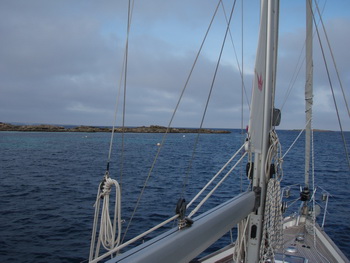
Arriving at the anchorage at Isla Espalmador
The wind never reached 10 knots so we motored the entire way. Only a few times did our sails help our speed although we kept the main out continuously to reduce roll from the swell. We motored at a speed that would give us 6 knots SOG (speed over ground) but sometimes we had to run the engine faster because of the adverse current. We tried to maintain about 1400 - 1600 rpms, using between 1 and 1.5 liters of fuel per hour. Unfortunately, several times we increased to 1800, using 2 liters per hour, and even went up to 2000 rpms, using 2.8 liters per hour while we crossed the traffic lanes of big ships. That is twice the fuel consumption of motoring at 1800 rpms and almost 3 times more than at 1400 rpms, but we wanted to clear the shipping lanes quickly.
It was a very relaxing crossing. Well, except for crossing the shipping lanes. At one point we had 3 large ships come within a mile or so of us. Our AIS gives us the actual direction and speed of the ships as well as the Closest Point of Approach so we knew we were safe. The day was clear and visibility was excellent.
We could see Ibiza from more than 30 miles but Formentera has no mountains and was not visible until we got much closer. Isla Espalmador, between the two, is only a few meters above sea level and we were very close by the time we saw it.
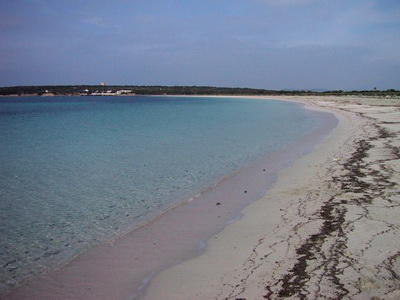
We had first seen pictures of Isla Espalmador in Paul and Sheryl Shard's DVD series, Cruising the Mediterranean. Jim bought the series while we were still living in Antwerp in the hopes of enticing me. It worked. We watched them all before ordering Tenaya. Our goal to sail out of chilly Northern Europe to the Mediterranean was no doubt influenced by their adventures.
The pilot book says the anchorage at Isla Espalmador is a tranquil and sheltered spot, but that it is a very popular anchorage "often containing up to a hundred yachts as well as tourist ferries and local craft". We are lucky to be here early in the season. On the morning of May 22 we are sharing the anchorage with 4 other boats. More boats are here during the day but few stay for the night.
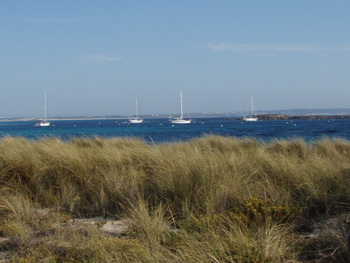
Sailboats, including Tenaya, moored at Isla Espalmador
The Posidonia oceanica sea grass is a marine plant that lives only in the Mediterranean. It forms extensive underwater meadows which produce diverse habitats. Numerous plants creatures find protection in them as well as shelter, a place for spawning and reproduction, and a source of nourishment. In fact it forms a whole community.
These meadows play an important ecological role in the environment. They produce organic matter and oxygen for their surroundings, help purify the water, trap sediments, contribute to beach protection through wave buffering and are the main source of sand in the Balearics.
In recognition of the need to save the Posidonia meadows, a program has been launched to educate the public and curb harmful activities such as seawater pollution, trawling by fishing boats, dredging and anchoring in sensitive areas.
It is common to see patches and even entire meadows of Posidonia sea grass in anchorages. There was quite a bit at Isla Espalmador. As we entered the anchorage we were surprised to find it filled with mooring balls. We assumed they allow more yachts to anchor safely, which is true. More importantly, they eliminate the need to anchor. Even so, a sailing yacht and 2 power boats dropped anchor instead of tying to moorings. It appears the Dept. of the Environment still has more educating to do.

Tenaya resting at her mooring
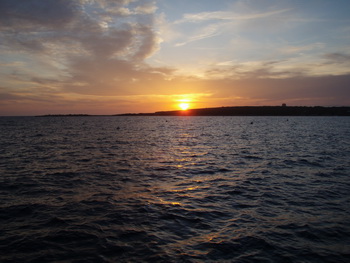
Sunset over Isla Espalmador
.
Small ferries dropped off visitors to spend a few hours on the island. About 5 pm the visitors were picked up and we yachties had the island to ourselves. That is when Jim and I took the dingy ashore to explore. We coasted along in no hurry to reach shore. Lots of jelly fish, the ones that look like mushrooms and have a nasty sting, floated by as we drifted over meadows of Posidonia sea grass and bright blue patches of sand. A beautiful beach of the finest sand is the closest point of land from the boat. We left the dingy there and walked along admiring the sea to the west and protected sand dunes to the east. As we left the protected, sandy anchorage the shore became rocky. As we rounded the point we found ourselves atop cliffs that were continually being eroded by the sea.
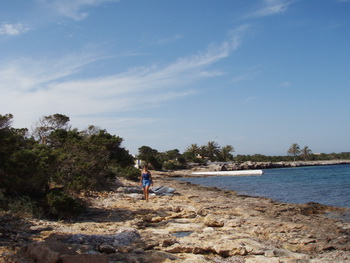
Katie walking along the waters edge
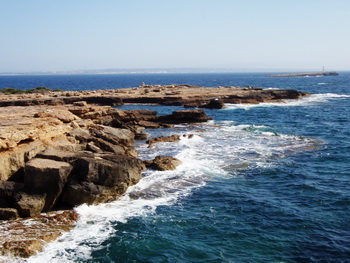
The rugged western shore of the island
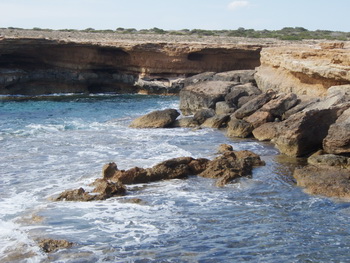
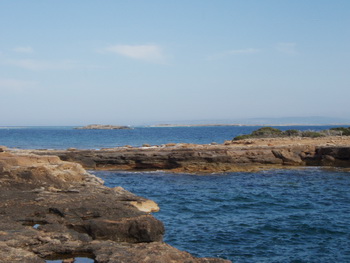
The south western shore looking south towards Formentera

A tower built in the 1800s

Looking inland from the beach
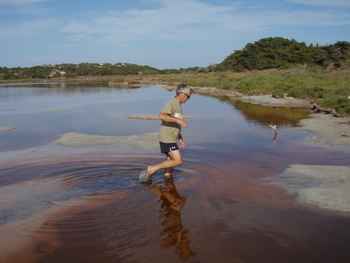
Jim walking through the mud bath in the center of the island. This was as far as either of us dared to dip our bodies.
My dream of diving off the stern and swimming in warm, clear water was dashed by the many jellyfish floating by the boat. Had I not read in Rod Heikell's Mediterranean Cruising Book that these creatures have a painful sting I probably would have ignored them as I never paid much attention to jellyfish in San Diego.
We are off to Ibiza to explore the city of the same name and find some peaceful coves. I sure hope I can swim there!
Find Espalmador on Google Earth
.